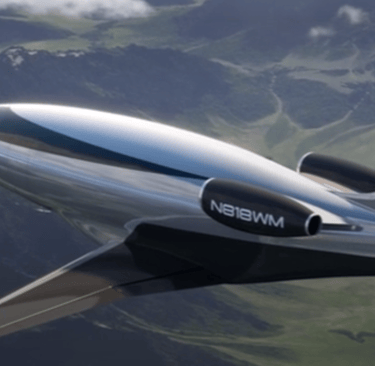Otto Aviation's Phantom 3500: A Leap Toward Sustainable Aviation
6/30/20254 min read


Introduction to the Phantom 3500
Otto Aviation has made a significant stride in the realm of sustainable aviation with the introduction of the Phantom 3500. Unveiled at the prestigious Paris Air Show in June 2025, this aircraft manifests a pivotal moment in the industry's ongoing journey toward achieving net-zero carbon emissions by 2030. The Phantom 3500 is not merely an advancement in design but rather a beacon of innovation that underscores the importance of environmentally responsible aviation solutions.
The unveiling of the Phantom 3500 is noteworthy, as it highlights the increasing urgency for sustainable practices within the aviation sector. As the world grapples with the pressing need to reduce its carbon footprint, the Phantom 3500 emerges as a promising contender capable of blending cutting-edge technology with eco-friendly operations. This aircraft is designed to significantly reduce emissions while maintaining safety and performance standards. Its culmination of innovative features challenges the status quo and exemplifies what the future of aviation can aspire to be.
Distinct from its competitors, the Phantom 3500 employs advanced aerodynamics and lightweight materials that enhance fuel efficiency. The aircraft is equipped with state-of-the-art propulsion systems that utilize sustainable fuels, effectively reducing reliance on traditional fossil fuels. Additionally, the incorporation of smart technologies ensures that operational efficiency is maximized, contributing to a decreased environmental impact. These characteristics not only enhance the aircraft’s performance but also establish it as a leading example of how the aviation industry can innovate responsibly.
The Phantom 3500's development is a testament to Otto Aviation's commitment to revolutionizing air travel. By prioritizing sustainability, the entity sets an example for future endeavors within the aviation field, essentially paving the way for more environmentally friendly innovations that can propel us toward a greener future.
Environmental Impact of the Aviation Industry
The aviation industry has rapidly expanded over the decades, providing connectivity and promoting global commerce. However, this growth comes at a significant environmental cost, particularly in terms of carbon dioxide (CO₂) emissions. The sector is responsible for approximately 2-3% of global CO₂ emissions, a figure that highlights the pressing need for sustainable practices. In comparison, the shipping industry accounts for around 3% of emissions, indicating that aviation is not alone in its environmental challenges, yet its impacts are more visible due to high-profile flights and airport operations.
As of today, several major aircraft manufacturers have set ambitious carbon neutrality goals. Notably, significant stakeholders in the aviation sector are pledging to achieve net-zero emissions by mid-century, aligning their strategies with the goals outlined in the Paris Agreement. However, the success of these initiatives depends on the adoption of innovative technologies, such as sustainable aviation fuels (SAF) and improvements in aircraft efficiency. While these efforts are commendable, they often lack a concrete timeline compared to Otto Aviation's revolutionary goal of achieving net-zero emissions by 2030, setting a new benchmark for the entire industry.
This proactive stance not only positions Otto Aviation as a leader in sustainable aviation but also resonates with the growing public concern regarding climate change. In recent years, there has been increasing pressure from consumers and environmental advocates for the aviation sector to reduce its carbon footprint. Studies indicate that a significant portion of travelers are now prioritizing airlines and companies that demonstrate a commitment to environmental sustainability. Hence, the urgency for change within the aviation industry is more pronounced than ever, necessitating swift actions and accountability to safeguard the planet for future generations.
Innovations and Features of the Phantom 3500
The Phantom 3500 by Otto Aviation stands out as a testament to cutting-edge technology in the realm of sustainable aviation. A key innovation of this aircraft is its AI-driven efficiency systems, designed to maximize performance while minimizing fuel consumption. These intelligent systems utilize real-time data analysis to optimize flight paths and engine performance, ensuring that every journey is as efficient as possible. By continuously adapting to atmospheric conditions and air traffic, the Phantom 3500 enhances operational efficiency, significantly reducing both fuel costs and environmental impact.
In an era where luxury often intertwines with environmental consciousness, the Phantom 3500 seamlessly brings together high-end features and sustainable practices. The aircraft boasts an elegantly designed cabin, equipped with state-of-the-art amenities that cater to the discerning tastes of the affluent market. Spacious interiors, premium materials, and intuitive onboard technology are not merely about comfort; they also reflect a commitment to sustainable luxury. For instance, renewable materials are utilized throughout the cabin, thereby reducing the overall carbon footprint.
Moreover, specific technologies embedded within the Phantom 3500 contribute to its reduced environmental impact. The aircraft incorporates advanced aerodynamics and lightweight composite materials, enhancing fuel efficiency while increasing payload capacity. Low-emission propulsion systems further ensure that each flight adheres to stringent environmental regulations. Additionally, the integration of hybrid-electric systems is a forward-thinking approach that aligns with global initiatives aimed at reducing aviation's carbon footprint. Through these innovations, the Phantom 3500 represents a significant step forward in sustainable aviation, promising a future where luxury does not come at the expense of the environment.
The Future of Private Aviation and Sustainability
As the aviation industry grapples with the challenge of reducing its carbon footprint, Otto Aviation's Phantom 3500 emerges as a noteworthy innovation that could redefine the future of private aviation. This aircraft exemplifies a proactive approach to sustainability while delivering luxury travel experiences. With increasing consumer awareness regarding environmental issues, the demand for sustainable aviation solutions has never been more pertinent. The Phantom 3500 not only showcases advanced aerodynamics and fuel efficiency but also aligns with a broader industry shift toward greener technologies.
The implications of the Phantom 3500 extend beyond merely introducing an environmentally friendly aircraft into the market. It sets a precedent for industry standards, prompting other manufacturers to rethink their design philosophies and production practices. As the aviation sector works to achieve net-zero emissions, Otto Aviation's leadership could inspire a wave of innovations, compelling competitors to integrate sustainable practices in their offerings. In this evolving landscape, we can anticipate a greater emphasis on reducing environmental impacts while enhancing passenger experiences.
Moreover, upcoming regulatory changes may catalyze this shift towards sustainable aviation. Governments worldwide are beginning to impose stricter emissions regulations and incentives for greener aircraft development. Consequently, the Phantom 3500 could serve as a benchmark for compliance, pushing the industry toward meeting stringent environmental norms. As manufacturers adjust to these changes, consumer expectations will likely play a pivotal role in shaping market trends. A growing segment of affluent travelers is increasingly interested in how their transportation choices impact the environment, which could lead to higher demand for eco-conscious private aviation options.
In this context, the Phantom 3500 not only represents a technological advancement but also highlights a crucial turning point in the aviation industry's journey toward sustainable development. As private aviation evolves, companies must align their goals with sustainable practices, balancing luxury and environmental responsibility in a market that will inevitably prioritize efficiency and eco-friendliness.
Luxury Conceirge for India's Elite Travelers.
C-160, MANSAROVER GARDEN, NEWDELHI-110015
11 RUE DE LA REYNIE, PARIS 75004, FRANCE
T-C-102, BUSINESS BAY, SJ ROAD, DUBAI
REACH US / SUBSCRIBE
care@dotrip.in
011-45637171 +91-8745000071
©DOTRIP 2025. All rights reserved.


